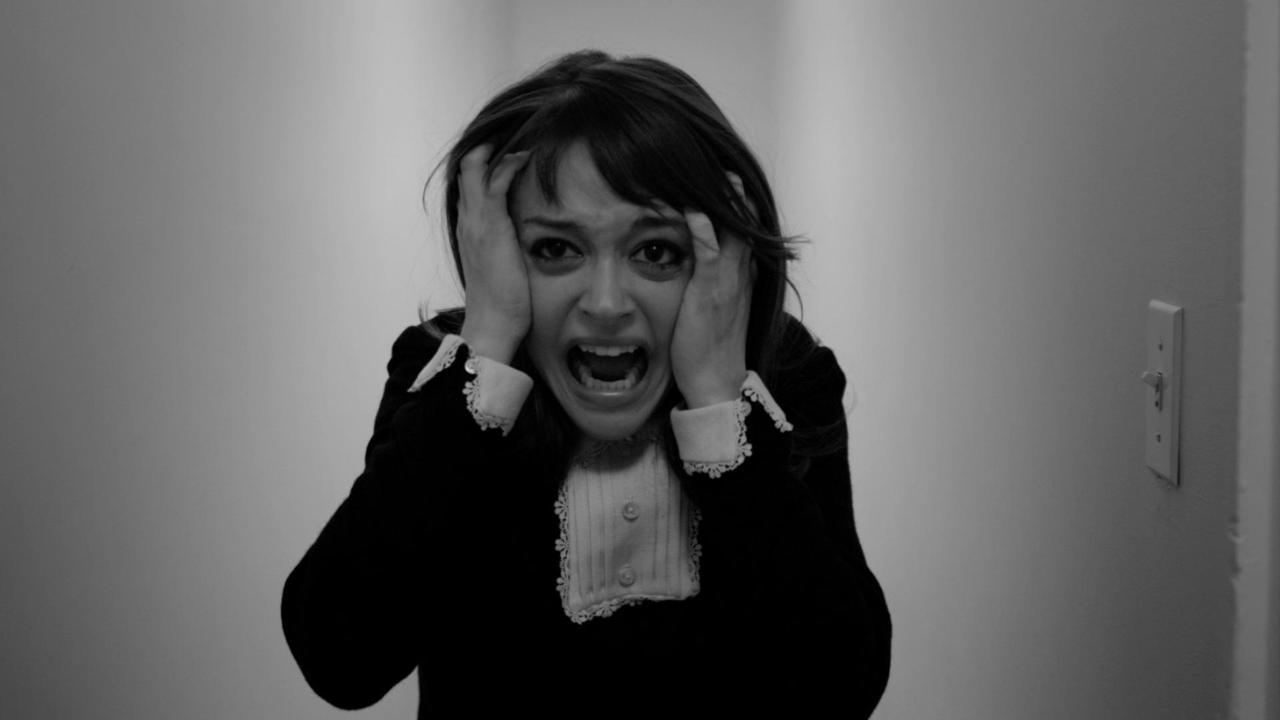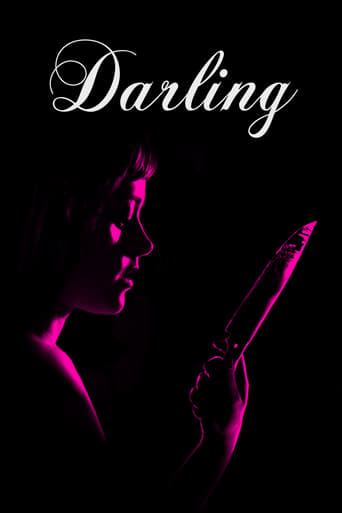

This film was just too pretentious for me to really get into in any meaningful way. I felt like it was trying way too hard to be some kind of quirky, black and white art-house movie and wound up putting more effort into this contrived style rather than making a movie with any substance. Director Mickey Keating — who also directed Pod, which I reviewed recently, which has literally all the same main characters minus Sean Young, as well as the same music composer AND same cinematographer — definitely knew what kind of mood he was aiming for, but he forgot to put any deep thought into things like dialogue or getting a strong performance out of his characters. I'm not entirely surprised, since Pod had the same issues for me — a good shell of a movie but no substantial filling."Darling" (she is given no other name), played by Lauren Ashley Carter, is a mysterious young girl who is tasked with watching an old, beautiful apartment in the heart of New York City while its wealthy residents are away. She is warned that a previous caretaker threw herself off the balcony, and there is talk of the apartment itself being haunted. Throughout the short time that she is house sitting we watch her descent into madness before her tragic end.** SPOILERS! **I guess my biggest issue with this movie is, as I mentioned, the fact that Keating's focus on style and mood seemed to trump his effort to build a meaningful character with Darling. He had this great opportunity to delve into the topics of gentrification, urban isolation, the trauma of possible sexual assault, and mental illness, to name a few, but he seemed to prefer to simply have a pretty girl stare blankly into the camera. We really never get to know much about her aside from studying every facet of her face since she probably stares into the camera for half the damn movie runtime. I had high hopes when the movie opened up with some impressively stark shots of the city — it's a rare treat when a movie seamlessly blends genuine terror and character development with an abundance of aesthetic beauty — but alas, all I got were some cool upside down shots of skyscrapers and enough shock cuts to make me never want to see another one again in my entire life.All of the mentions of a paranormal side of things — the apartment being haunted, the previous caretaker committing suicide, the mention by her date that a conjuring of the devil was once attempted in the building — are all sadly glossed over, despite the fact that they could have been interesting additions to the plot if they were explored a bit more. It does what many other greats before it have done — blurring the line and making us wonder what is truly paranormal and what is a product of spiraling into madness — but it just doesn't do it nearly as well.The murder of her date was unexpected, and somewhat shocking to witness — him gasping awake unexpectedly and the subsequent suffocation with the plastic bag were particularly hard to watch. But ultimately, like most aspects of the movie — I mean, come on, it's broken into chapters for some inexplicable reason — I felt like it was trying a bit too hard.Then the ending just gets plain cheesy, with her talking to Madame on the phone, hinting again at her past trauma, and saying "I think I'll become one of your ghost stories now" *eye roll*.Overall, YAWN. Pretty to look at? Sure. But I would have preferred it spend more time making me think — or, hell, scaring me — than repeatedly juxtaposing her blank expression with a strobed shot of her screaming face.
... View MoreOpening with some stunning panoramic shots of New York City, all crisp skylines and looming buildings, this film could have taken place in any era. Although there is no specified time in which these events are set, the style of décor and clothing seems to indicate anything from the 1930s to the 1960s. Filmed in monochrome, this provides a timeless and stylish David Lynch-ian study into madness.In the middle of all this, little Lauren Ashley Carter as Darling is about to take on a job as Caretaker of a mansion. As soon as Madame says, "I really shouldn't tell you this, but " the scene is set: the previous caretaker has met with an untimely demise but Darling is assured she has nothing to worry about. No matter how artistically shot this is, and how wilfully playful some of it may be, an opening like that never fails to sound clunky.And so, to the accompaniment of shrieking violins and jumping, jerky camera movements, we are invited to observe Darling very convincingly succumb to madness. And that takes up the bulk of the film – often without dialogue and very ably played by Carter, there is nevertheless a sense of 'is that it?' Even as she goes to great lengths to end the life of her new guest (played by Brian Morvant) and then nervously heaves his corpse into an empty bath, it becomes clear Darling's instability is all we're going to get in terms of story-telling.Darling's alienation and severance from the rest of the bustling society is palpable, and Carter retains great presence as she continually slides further into her isolation (her eyes almost take on a performance of their own), the overall effect is one of intimate turmoil which appears to manifest from building itself.To further distance itself from the trappings of normal filmed story-telling, this is split into six chapters – Her, Invocation, THRILLS, Demon, Inferno and The Caretaker.
... View MoreLike visiting The Museum of Modern Art, Darling needs to be approached from the right state of mind to connect with it. Its value lies more in how its story is told rather than the details of the narrative itself; a kind of filmmaking that hearkens back to expressionist films of the 1920s. It's exciting that micro-budget indie filmmakers are now able to reach audiences via steaming services and attempt these kinds of artistic explorations that you simply won't see from larger productions, let alone Hollywood.The story is simple and classic: A young woman takes a job as a caretaker of a haunted mansion and weird things begin to happen. But the film only uses the narrative as means of providing us with familiarity while focusing our attention on its visual presentation. And Darling is all about the visuals; the script can't be more than a few pages. Long periods pass with a single, well-composed shot creating a sense of wonder and uncertainty in the viewer. The choice of black & white cinematography allows the camera to always be in control, reminding us that everything we see is slightly unreal, especially when moments of powerful violence happen. If it were shot in color, the gore would have been the message and distracted us from the artistic statement.Darling is not for everyone, and horror film aficionados may be disappointed or consider it pretentious. And it does start off slow: it took the first 15 minutes for me to relax and not try to rush it.Lauren Ashley Carter is captivating in the lead role, appearing in nearly every shot. She conveys a shifting range of emotions causing me to feel sympathy for her seeming innocence then later repulsing me by her brutality. She gets the avant-garde nature of this production and finds the right tone in every scene.Look for Larry Fessenden (Habit) in a bit part toward the end. I recommend Darling for the vision it attempted and mostly succeeded at presenting us with. It's not a typical horror film, but something to be watched and admired for its beauty and simplicity.
... View More"Darling" follows an out-of-touch young woman who gets a job house sitting in a large New York mansion that is reputed to be haunted—that's about all I can say without ruining the rest of the film, as it really is that paper-thinly plotted.Writer/director Mickey Keating seems to be a serious film student, as the movie is entirely based on Polanski's "Repulsion," and has shades of "The Shining" and "Diabolique" worn on its shoulder at all times. This is perhaps the most frustrating thing about it—the fact that it lacks its own identity.The film is nicely shot and has some great closeups which are accentuated by the black-and-white cinematography, and the setting has an off-kilter, claustrophobic vibe that is more or less effective; I did, however, find the flashy jump-cuts and strobe effects to be overwrought. Lauren Ashley Carter plays the lead of the picture, and even looks like Catherine Deneuve; her performance is solid, while Brian Morvant plays a male counterpart who takes on a vital role in the proceedings. The film has a downbeat ending at its 76 minute running time, but it's a conclusion that seems apparent from the opening scene.Overall, "Darling," though a technically well-made film, lacks bite because it seems too preoccupied with paying homage. A meatier film could have gotten away with this, but the narrative here is far too basic and skeletal to offset a cache of cross-references. The result is stylistically effective, but unfortunately rather dull in all other areas. 4/10.
... View More